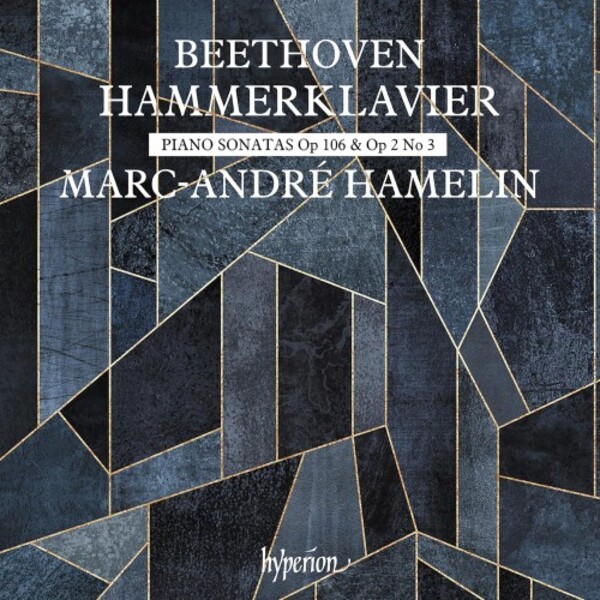BEETHOVEN Piano Sonatas Nos 3 & 29 (Marc-André Hamelin)
View record and artist detailsRecord and Artist Details
Genre:
Instrumental
Label: Hyperion
Magazine Review Date: 11/2024
Media Format: CD or Download
Media Runtime: 69
Mastering:
DDD
Catalogue Number: CDA68456

Tracks:
| Composition | Artist Credit |
|---|---|
| Sonata for Piano No. 3 |
Ludwig van Beethoven, Composer
Marc-André Hamelin, Piano |
| Sonata for Piano No. 29, 'Hammerklavier' |
Ludwig van Beethoven, Composer
Marc-André Hamelin, Piano |
Author: Jed Distler
Marc-André Hamelin launches into the Hammerklavier Sonata’s opening Allegro with both assertion and transparency. He intelligently scales his dynamics and times the silences to navigate and illuminate the music’s contrasting peaks and valleys most effectively. Both here and in the recapitulation, the passages in broken chords are crisp, assertive and full-bodied, with little help from the sustain pedal. Note the ebb and flow with which Hamelin clarifies the second subject’s cascading entrances between the hands. One small detail caught my ear: most pianists make a ritard over the triplet up beat in bar 99 leading into bar 100’s dolce ed espressivo. Here, however, Hamelin plays the triplet in tempo as written, while inserting a minuscule breath pause in between the two bars – an unusual yet effective solution to a longtime textual sticky wicket. In the ascending chain of broken fifths and sixths just before the recapitulation (bars 224 26), Hamelin favours the logical A natural over the A sharp ‘misprint masterstroke’ espoused by Schnabel, Arrau and Pollini. Personally I prefer A sharp, yet Hamelin stands his ground.
Hamelin’s relatively sedate Scherzo surprises: I miss the curt accentuations and angular bite that Murray Perahia, Anton Kuerti and Peter Serkin brought to this movement. Yet Hamelin’s forceful left-hand dynamic surges and astute phrase groupings in the Trio shed fresh light on the composer’s slippery rhythmic displacements.
At first the Adagio sostenuto seemed cool and reserved when measured alongside the noticeable shifts in voicing and weightier countenance from Hamelin’s two Hyperion Hammerklavier rivals, Angela Hewitt (2/22) and Steven Osborne (10/16). It took several hearings for Hamelin’s subtlety to register. In the opening pages, for example, Hamelin constantly moves over the bar lines by imposing the tiniest inflections of phrase and elongations of beats. As the music grows increasingly decorative and elaborate, Hamelin gradually expands his expressive palette, assiduously building to a shattering climax. In short, Hamelin’s masterful marshalling of small details reveals both the majesty and the inherent classicism of Beethoven’s architecture.
Hamelin probes the fourth movement’s Largo introduction as if reluctant to let go of the ideas that Beethoven quickly proposes and discards. By aiming for clarity, lightness and crystalline articulation, Hamelin’s basic tempo for the fugue sounds faster than it actually is; indeed, one can take dictation from the pianist’s lucid voice-leading. What is more, Hamelin avoids the usual trap of tempos slowing down and textures growing thicker, a tendency that many pianists unfortunately share.
Beethoven’s early C major Sonata elicits some of Hamelin’s most characterful and witty playing in the opening Allegro con brio. Again, the bracing impact of his intelligent scaling of dynamics fires up the Scherzo, not to mention the refined textural layering of the Allegro assai’s long trills. Some listeners may find Hamelin’s Adagio more of an andante con moto, yet his sharply defined legato/détaché differentiation and flexibly singing line demonstrate what the Classical style is all about. But why doesn’t Hamelin observe the first-movement exposition repeat? Excellent sound and insightful annotations by Beethoven scholar Barry Cooper bolster my warm recommendation.
Discover the world's largest classical music catalogue with Presto Music.

Gramophone Digital Club
- Digital Edition
- Digital Archive
- Reviews Database
- Full website access
From £8.75 / month
Subscribe
Gramophone Full Club
- Print Edition
- Digital Edition
- Digital Archive
- Reviews Database
- Full website access
From £11.00 / month
Subscribe
If you are a library, university or other organisation that would be interested in an institutional subscription to Gramophone please click here for further information.





